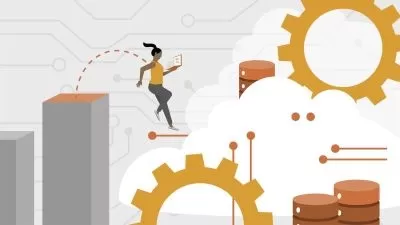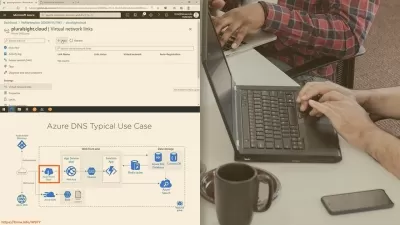Azure Mastery: DP-100| AI-900| DP-900| DP-300| AI Chatbot
EDUCBA Bridging the Gap
43:08:55
Description
Master Microsoft Azure and elevate your career with our comprehensive, hands-on course. Prepare for exams too.
What You'll Learn?
- Create and manage Azure Machine Learning workspaces.
- Develop and submit machine learning pipelines using Azure ML Designer and SDK.
- Understand AI concepts and explore common AI workloads.
- Utilize Azure Cognitive Services for computer vision and natural language processing (NLP).
- Learn data representation and storage options in Azure, including SQL and Cosmos DB.
- Set up and manage Azure SQL databases, ensuring security and scalability.
- Understand the fundamentals of cloud computing and Azure's core services.
- Create and manage virtual machines, storage solutions, and virtual networks in Azure.
- Implement high availability and scaling solutions for Azure resources.
- Create and manage Azure Data Lake, including data processing and analytics.
Who is this for?
What You Need to Know?
More details
DescriptionWelcome to the Microsoft Azure Mastery Course, a comprehensive learning journey designed to equip you with the knowledge and skills needed to excel in the rapidly evolving field of cloud computing and data science. This course covers a wide array of topics, from foundational principles to advanced applications, ensuring a well-rounded understanding of Microsoft Azure's extensive capabilities.
Microsoft Azure is one of the leading cloud platforms, offering a vast range of services that support various business needs, including data storage, machine learning, AI, and database management. With the increasing demand for cloud-based solutions, proficiency in Azure has become a valuable asset for IT professionals, data scientists, and developers.
Our course is structured into distinct sections, each focusing on a specific aspect of Azure. You will start with an introduction to Azure's data science capabilities and progress through foundational AI concepts, data fundamentals, and relational database management. Practical sections on cognitive services and AI-based chatbot creation will enhance your hands-on experience, while sections on Azure essentials and data lake management will solidify your foundational knowledge.
Whether you are preparing for Microsoft certification exams or seeking to expand your practical skills, this course offers a blend of theoretical knowledge and practical application. You will engage with interactive lessons, real-world scenarios, and step-by-step guides, ensuring a robust learning experience.
By the end of this course, you will be well-prepared to leverage Microsoft Azure's powerful tools and services, ready to tackle complex challenges and drive innovation in your organization. Welcome to your journey towards Azure mastery!
Section 1: DP-100 Microsoft Azure Data Science Exam
In this section, you will gain comprehensive knowledge and hands-on experience with Microsoft Azure's data science capabilities. Starting with an introduction to the course and exam requirements, you will learn how to create and manage an Azure Machine Learning workspace, including its settings through the portal and Azure ML Studio. The section covers the creation and management of datasets, compute instances, and clusters, and takes you through building and submitting machine learning pipelines. You'll delve into custom code, error handling, and understanding complex pipelines, ensuring a thorough grasp of Azure ML Designer and SDK setup. The section also introduces AutoML, model registration, deployment strategies, and production compute targets, preparing you for real-world applications of Azure's machine learning tools.
Section 2: AI-900 MS Azure AI Fundamentals
This section is designed to provide a foundational understanding of artificial intelligence (AI) and its applications within Microsoft Azure. Beginning with an introduction to AI and the AI-900 exam requirements, you will explore common AI workloads, responsible AI principles, and privacy and security considerations. The section covers various machine learning types, dataset features, and the training and validation process. You'll gain practical experience with AutoML, machine learning designer tools, and common computer vision and natural language processing (NLP) workloads, using Azure's services to build and deploy models without extensive coding. This section is perfect for those new to AI and seeking to understand its fundamentals and applications.
Section 3: DP-900 Azure Data Fundamentals
Section 3 focuses on the basics of data representation, storage options, and data workloads within Azure. You'll start with an introduction to the DP-900 exam requirements, followed by an exploration of relational and non-relational databases, including normalization, SQL, and NoSQL databases. Practical demos will guide you through creating databases, views, stored procedures, and indexes, as well as deploying and managing Azure SQL and Cosmos DB. This section also covers modern data warehousing, Azure Data Factory, and data visualization tools like Power BI, providing a comprehensive overview of Azure's data services and their practical applications.
Section 4: DP-300 Azure Relational DBA
This section prepares you for managing relational databases in Azure. After an introduction and overview of the DP-300 exam requirements, you'll learn about Azure's SQL database options, creating and managing Azure VMs, and deploying SQL servers. Topics include functional and scaling requirements, availability and backup strategies, and security measures for SQL databases. You will explore scaling techniques, SQL database replicas, sharding, and data synchronization. The section also covers migration and upgrade strategies, ensuring you are well-equipped to handle Azure SQL database management and optimization.
Section 5: Microsoft Azure - Basics
In Section 5, you will explore the fundamentals of Microsoft Azure and cloud computing. Starting with an overview of cloud computing principles and the history of Azure, you'll learn about key cloud services, deployment models, and the architecture of Microsoft Azure. The section covers account registration, the Azure portal, and various tools for managing Azure services, including PowerShell and CLI. You will gain practical knowledge of Azure virtual machines, storage options, and networking configurations, preparing you to leverage Azure's capabilities for various cloud-based applications and services.
Section 6: Azure Practical - Cognitive Services
Section 6 provides an in-depth look at Azure's cognitive services, focusing on practical applications. You'll begin with an introduction to Azure Cognitive Services and the creation of a free tier account. The section covers vision APIs, computer vision, face API, custom vision, form recognizer, and video indexer, with hands-on exercises for each service. You'll also explore speech APIs, including speech-to-text, text-to-speech, and translation services. Additionally, the section covers language services, sentiment analysis, entity recognition, and the QnA Maker, providing a comprehensive understanding of how to implement cognitive services in real-world scenarios.
Section 7: Azure Cognitive Services - Creating an AI-Based Chatbot
In this section, you will learn how to create an AI-based chatbot using Azure Cognitive Services. Starting with an introduction to the course, you'll explore the QnA service, Java application creation, and resolving issues within the application. The section provides practical steps for running and deploying the chatbot application, ensuring you have the skills to develop and manage AI-based chatbots effectively.
Section 8: Microsoft Azure - Essentials
Section 8 covers the essential principles and services of Microsoft Azure. Beginning with an introduction to Azure essentials, you will learn about the five principles of cloud computing, the history of cloud computing, and key types of cloud services. The section also covers cloud deployment models, Azure's architecture, and account registration. Practical demos will guide you through the Azure Resource Manager (ARM) and Azure Service Manager (ASM) portals, subscription management, and the installation and usage of Azure PowerShell and CLI. This section provides a solid foundation for understanding and utilizing Microsoft Azure's core services.
Section 9: Microsoft Azure - Data Lake
The final section focuses on Azure Data Lake, offering an introduction and overview of its components and services. You will learn how to create analytics accounts, process data within the Data Lake Store, and use the USQL language for data manipulation. The section covers defining analytics units, job stages, data ingestion, and processing multiple files. You'll also explore Azure Data Lake's integration with Visual Studio, monitoring and analyzing jobs, and using PowerShell and CLI for data management. The section concludes with a summary of Azure Data Lake's pricing and capabilities, equipping you with the knowledge to leverage this powerful data storage and processing solution.
Conclusion
By the end of this comprehensive course, you will have a deep understanding of Microsoft Azure's data science, AI, data fundamentals, relational database management, cognitive services, and cloud computing basics. Each section provides practical knowledge and hands-on experience, preparing you for various Azure certification exams and real-world applications of Azure's services. Whether you are a beginner or an experienced professional, this course will enhance your skills and help you leverage Azure's capabilities to their fullest potential.
Who this course is for:
- Aspiring Data Scientists: Individuals aiming to build a career in data science and machine learning using Microsoft Azure.
- Data Engineers: Professionals involved in designing and managing data processing systems who want to incorporate machine learning capabilities.
- AI Engineers: Those interested in developing AI solutions on the Azure platform.
- IT Professionals: System administrators or IT managers looking to understand Azure's capabilities for machine learning and data analytics.
- Students and Graduates: Those pursuing studies in computer science, data science, or related fields seeking practical knowledge of Azure's data science offerings.
- Professionals Transitioning to Data Science: Individuals from non-technical backgrounds looking to transition into data science and AI roles.
- Technology Enthusiasts: Anyone passionate about exploring advanced data analytics and machine learning in the cloud environment.
Welcome to the Microsoft Azure Mastery Course, a comprehensive learning journey designed to equip you with the knowledge and skills needed to excel in the rapidly evolving field of cloud computing and data science. This course covers a wide array of topics, from foundational principles to advanced applications, ensuring a well-rounded understanding of Microsoft Azure's extensive capabilities.
Microsoft Azure is one of the leading cloud platforms, offering a vast range of services that support various business needs, including data storage, machine learning, AI, and database management. With the increasing demand for cloud-based solutions, proficiency in Azure has become a valuable asset for IT professionals, data scientists, and developers.
Our course is structured into distinct sections, each focusing on a specific aspect of Azure. You will start with an introduction to Azure's data science capabilities and progress through foundational AI concepts, data fundamentals, and relational database management. Practical sections on cognitive services and AI-based chatbot creation will enhance your hands-on experience, while sections on Azure essentials and data lake management will solidify your foundational knowledge.
Whether you are preparing for Microsoft certification exams or seeking to expand your practical skills, this course offers a blend of theoretical knowledge and practical application. You will engage with interactive lessons, real-world scenarios, and step-by-step guides, ensuring a robust learning experience.
By the end of this course, you will be well-prepared to leverage Microsoft Azure's powerful tools and services, ready to tackle complex challenges and drive innovation in your organization. Welcome to your journey towards Azure mastery!
Section 1: DP-100 Microsoft Azure Data Science Exam
In this section, you will gain comprehensive knowledge and hands-on experience with Microsoft Azure's data science capabilities. Starting with an introduction to the course and exam requirements, you will learn how to create and manage an Azure Machine Learning workspace, including its settings through the portal and Azure ML Studio. The section covers the creation and management of datasets, compute instances, and clusters, and takes you through building and submitting machine learning pipelines. You'll delve into custom code, error handling, and understanding complex pipelines, ensuring a thorough grasp of Azure ML Designer and SDK setup. The section also introduces AutoML, model registration, deployment strategies, and production compute targets, preparing you for real-world applications of Azure's machine learning tools.
Section 2: AI-900 MS Azure AI Fundamentals
This section is designed to provide a foundational understanding of artificial intelligence (AI) and its applications within Microsoft Azure. Beginning with an introduction to AI and the AI-900 exam requirements, you will explore common AI workloads, responsible AI principles, and privacy and security considerations. The section covers various machine learning types, dataset features, and the training and validation process. You'll gain practical experience with AutoML, machine learning designer tools, and common computer vision and natural language processing (NLP) workloads, using Azure's services to build and deploy models without extensive coding. This section is perfect for those new to AI and seeking to understand its fundamentals and applications.
Section 3: DP-900 Azure Data Fundamentals
Section 3 focuses on the basics of data representation, storage options, and data workloads within Azure. You'll start with an introduction to the DP-900 exam requirements, followed by an exploration of relational and non-relational databases, including normalization, SQL, and NoSQL databases. Practical demos will guide you through creating databases, views, stored procedures, and indexes, as well as deploying and managing Azure SQL and Cosmos DB. This section also covers modern data warehousing, Azure Data Factory, and data visualization tools like Power BI, providing a comprehensive overview of Azure's data services and their practical applications.
Section 4: DP-300 Azure Relational DBA
This section prepares you for managing relational databases in Azure. After an introduction and overview of the DP-300 exam requirements, you'll learn about Azure's SQL database options, creating and managing Azure VMs, and deploying SQL servers. Topics include functional and scaling requirements, availability and backup strategies, and security measures for SQL databases. You will explore scaling techniques, SQL database replicas, sharding, and data synchronization. The section also covers migration and upgrade strategies, ensuring you are well-equipped to handle Azure SQL database management and optimization.
Section 5: Microsoft Azure - Basics
In Section 5, you will explore the fundamentals of Microsoft Azure and cloud computing. Starting with an overview of cloud computing principles and the history of Azure, you'll learn about key cloud services, deployment models, and the architecture of Microsoft Azure. The section covers account registration, the Azure portal, and various tools for managing Azure services, including PowerShell and CLI. You will gain practical knowledge of Azure virtual machines, storage options, and networking configurations, preparing you to leverage Azure's capabilities for various cloud-based applications and services.
Section 6: Azure Practical - Cognitive Services
Section 6 provides an in-depth look at Azure's cognitive services, focusing on practical applications. You'll begin with an introduction to Azure Cognitive Services and the creation of a free tier account. The section covers vision APIs, computer vision, face API, custom vision, form recognizer, and video indexer, with hands-on exercises for each service. You'll also explore speech APIs, including speech-to-text, text-to-speech, and translation services. Additionally, the section covers language services, sentiment analysis, entity recognition, and the QnA Maker, providing a comprehensive understanding of how to implement cognitive services in real-world scenarios.
Section 7: Azure Cognitive Services - Creating an AI-Based Chatbot
In this section, you will learn how to create an AI-based chatbot using Azure Cognitive Services. Starting with an introduction to the course, you'll explore the QnA service, Java application creation, and resolving issues within the application. The section provides practical steps for running and deploying the chatbot application, ensuring you have the skills to develop and manage AI-based chatbots effectively.
Section 8: Microsoft Azure - Essentials
Section 8 covers the essential principles and services of Microsoft Azure. Beginning with an introduction to Azure essentials, you will learn about the five principles of cloud computing, the history of cloud computing, and key types of cloud services. The section also covers cloud deployment models, Azure's architecture, and account registration. Practical demos will guide you through the Azure Resource Manager (ARM) and Azure Service Manager (ASM) portals, subscription management, and the installation and usage of Azure PowerShell and CLI. This section provides a solid foundation for understanding and utilizing Microsoft Azure's core services.
Section 9: Microsoft Azure - Data Lake
The final section focuses on Azure Data Lake, offering an introduction and overview of its components and services. You will learn how to create analytics accounts, process data within the Data Lake Store, and use the USQL language for data manipulation. The section covers defining analytics units, job stages, data ingestion, and processing multiple files. You'll also explore Azure Data Lake's integration with Visual Studio, monitoring and analyzing jobs, and using PowerShell and CLI for data management. The section concludes with a summary of Azure Data Lake's pricing and capabilities, equipping you with the knowledge to leverage this powerful data storage and processing solution.
Conclusion
By the end of this comprehensive course, you will have a deep understanding of Microsoft Azure's data science, AI, data fundamentals, relational database management, cognitive services, and cloud computing basics. Each section provides practical knowledge and hands-on experience, preparing you for various Azure certification exams and real-world applications of Azure's services. Whether you are a beginner or an experienced professional, this course will enhance your skills and help you leverage Azure's capabilities to their fullest potential.
Who this course is for:
- Aspiring Data Scientists: Individuals aiming to build a career in data science and machine learning using Microsoft Azure.
- Data Engineers: Professionals involved in designing and managing data processing systems who want to incorporate machine learning capabilities.
- AI Engineers: Those interested in developing AI solutions on the Azure platform.
- IT Professionals: System administrators or IT managers looking to understand Azure's capabilities for machine learning and data analytics.
- Students and Graduates: Those pursuing studies in computer science, data science, or related fields seeking practical knowledge of Azure's data science offerings.
- Professionals Transitioning to Data Science: Individuals from non-technical backgrounds looking to transition into data science and AI roles.
- Technology Enthusiasts: Anyone passionate about exploring advanced data analytics and machine learning in the cloud environment.
User Reviews
Rating
EDUCBA Bridging the Gap
Instructor's Courses
Udemy
View courses Udemy- language english
- Training sessions 370
- duration 43:08:55
- Release Date 2024/08/11











